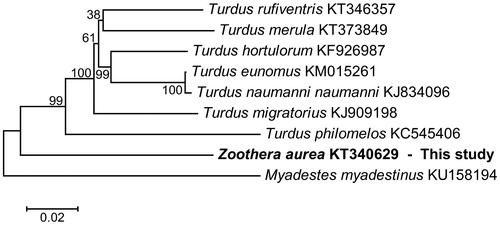Abstract
The white’s thrush Zoothera aurea (Aves, Passeriformes, Turdidae) breeds in wet boreal forest with pinophyta, in eastern Asia and Siberia. The complete mitochondrial genome sequence consisted of 16,778 base pairs (bp) encoding 13 protein-coding genes (PCGs), 2 ribosomal RNAs (rRNAs), 22 transfer RNAs (tRNAs), and non-coding regions. The overall base composition of Z. aurea was G + C: 47.1%, A + T: 52.9%, apparently with a slight AT bias. Phylogenetic analysis showed that Z. aurea was closely related to Turdus philomelos.
Keywords:
The white’s thrush Zoothera aurea (Aves, Passeriformes, Turdidae) breeds in wet boreal forest with pinophyta, in eastern Asia and Siberia. Previously, it was called Zoothera dauma aurea or Zoothera dauma, and was separated by a species. Now there are about 20 species in genus Zoothera. Despite the changes in the classification of species, there is no study on the whole mitochondrial genome of this genus. Zoothera aurea was collected at Palgongsan Mountain (36.013069 N 128.463747 E) in Korea. This specimen was deposited in the Institute of Ornithology, Kyungpook National University, Daegu, Republic of Korea.
In the present study, the mitogenome of Z. aurea was completely sequenced and submitted to GenBank (accession number: KT340629). The sequence was compared with a previously reported mitogenome sequence of Turdus hortulorum (Yan et al. Citation2016). The mitochondrial DNA was amplified into two overlapping segments by a long-range PCR method (Koh et al. Citation2018). DNA shotgun sequencing was operated by an Ion PGM™ system (Life Technologies, Gaithersburg, MD, USA), and genome assembly was carried out using the CLC Genomics Workbench 7.5 program (CLC Bio, Denmark).
The mitogenome was 16,778 bp in size, consisting of 13 protein-coding genes (PCGs), 2 ribosomal RNAs (rRNAs) genes, 22 transfer RNAs (tRNAs), and non-coding region (D-loop). All the PCGs (ND1, CO2, ATP8, ATP6, CO3, ND3, ND4L, ND4, ND5, CytB, ND6) shared start codon ‘ATG’, except for ND2 (start codon ‘GTG’) and CO1 (start codon ‘ATC’). Regarding the stop codons, 6 PCGs (CO2, ATP8, ATP6, ND3, ND4L, CytB) shared stop codon ‘TAA’, 2 PCGs (ND1, ND5) shared stop codon ‘AGA’, 2 PCGs (CO3, ND4) shared the incomplete stop codon ‘T––’, CO1 terminated with AGG, ND6 terminated with TAG, and ND2 terminated with TA. The two rRNA genes were 12S rRNA (981 bases) and 16S rRNA (1595 bases). The D-loop (1205 bases) was located between tRNA-Glu and tRNA-Phe. The overall base composition of Z. aurea was G: 14.8%, C: 32.3%, A: 29.7%, T: 23.2%, apparently with a slight AT bias (G + C: 47.1%, A + T: 52.9%).
We compared the results from the present study with the previous mitogenome research on the genus Turdus and genus Myadestes (Barker Citation2014; Gibb et al. Citation2015; Li et al. Citation2016; Anmarkrud and Lifjeld Citation2017; Gomes de Sá et al. Citation2017). Phylogenetic analysis based on the mitogenome sequences using the maximum likelihood general time reversible model (GTR) with gamma-distributed (G) plus Invariant sites (I) method showed that the Z. aurea was closely related to Turdus philomelos (). Thus, the Z. aurea mitogenome sequence can contribute to phylogenetic knowledge of the genus Zoothera and expand the basis of the thrush species.
Disclosure statement
No potential conflict of interest was reported by the authors.
References
- Anmarkrud JA, Lifjeld JT. 2017. Complete mitochondrial genomes of eleven extinct or possibly extinct bird species. Mol Ecol Res. 17:334–341.
- Barker FK. 2014. Mitogenomic data resolve basal relationships among passeriform and passeridan birds. Mol Phylogen Evol. 79:313–324.
- Gibb GC, England R, Hartig G, McLenachan PA, Taylor Smith BL, McComish BJ, Cooper A, Penny D. 2015. New Zealand passerines help clarify the diversification of major songbird lineages during the Oligocene. Genome Biol Evol. 7:2983–2995.
- Gomes de Sá P, Veras A, Fontana CS, Aleixo A, Burlamaqui T, Mello CV, de Vasconcelos ATR, Prosdocimi F, Ramos R, Schneider M, Silva A. 2017. The assembly and annotation of the complete Rufous-bellied Thrush mitochondrial genome. Mitochondrial DNA Part A. 28:231–232.
- Koh H, Park GS, Shin SM, Park CE, Kim S, Han SJ, Pham HQ, Shin JH, Lee DW. 2018. Mitochondrial mutations in cholestatic liver disease with biliary atresia. Sci Rep. 8:905.
- Li B, Zhou L, Liu G, Gu C. 2016. Complete mitochondrial genome of Naumann’s thrush Turdus naumanni (Passeriformes: Turdidae). Mitochondrial DNA Part A. 27:1117–1118.
- Yan L, Zhang HB, Yan P, Wu XB. 2016. The complete mitochondrial genome of Turdus hortulorum (Passeriformes, Turdidae). Mitochondrial DNA Part A. 27:543–544.

